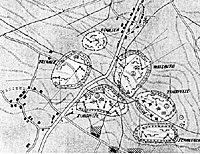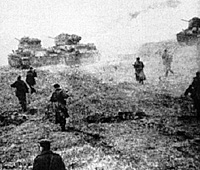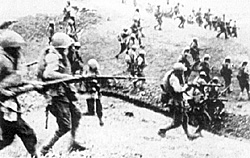First things first, this is no movie review. I do not intend to take Hollywood to task on any issue, nor do I want to evaluate the issue of movies matching (or even resembling) the book of the same name. What I do want to do is examine the tactical handling of the troops in Starship Troopers for lessons that can be applied to a TCS game. Fortunately (?), the troopers in the movie paid the price for these mistakes -- so one is not left wondering if they really were mistakes.
1 Fire Support is Good
In the first landing on the hostile planet, the "troopers" did so without any fire support at all. I would presume the star cruisers in orbit around the enemy world had plenty of weapons with which to flatten the entire planet's surface (at least the "big bugs" that were supplying flak fires!). The result was that soon after the troopers landed, the "unsuppressed" bugs appeared all over the landing zone to deal the arrogant humans the defeat they deserved.
In TCS terms, the troopers ran up the objective without any suppressing artillery, air or even MG fires. The TCS player can already predict the result of such inattention to details. The only thing working in the troopers' favor is the fact that the bugs didn't possess projectile weapons. Believe me, your opponent has them and will be happy to use them to full advantage.
2. More Fire Support is Better!
On the second assault landing, the troopers wised up and laid waste to the LZ before hitting the "beach." (They must have gotten an Ops subber to send them a letter to the editor.) So far so good, but even before the landing actually touched ground, the supporting "aircraft" departed their station and left for the high ground. Much like the Marines at Iwo Jima or Tarawa, promises of an easy landing -- where all the ground troops had to do was clean up -- failed miserably.
Once more, the troopers were sacrificed to tactical mistakes. Once they were surrounded by millions of bugs in the Rorke's Drift style fort, just a handful of sorties would have had a field day slicing through the packed bug ranks. These, however, never appeared.
As any TCS player knows, an army is most vulnerable right after taking an objective. At such a time, even the best troops are prone to letting their guard down for a short time while they regroup, tend to the wounded, and root out the last defenders. At that very point, the counterattack doctrine of many nations (most notably German defensive doctrine in both world wars) focuses on defeating the enemy attack.
This being the case, the TCS player prepares first by developing the defensive plan in advance so that the period of vulnerability is as small as possible, and by keeping some artillery, air strikes, or even just mortar fires in reserve to pound any attempt by the enemy to retake the newly won objective. In the movie, this was not done, and (again) the ground troops paid the price.
3. Bring Heavy Weapons
Apparently, there were only two kinds of weapons available to these interstellar storm troopers: their personal automatic rifles, and a kind of rifle grenade they insisted on calling a "nuke." Their personal weapons appeared to be nothing more than M16s with fancy plastic grips: a weapon which requires a full clip to be emptied at point blank range in order to kill one bug. One would think some sort of armament would have been available to kill a bug in only a few rounds at most (one would be best).
On the other end of the spectrum is the "nuke" rifle grenade. Here we have a weapon that can only be used when directed by command authority, has a rate of fire that resembles "DORA," and is really good at taking out exactly one large target at fairly long range. As I recall, three of these things were used during the entire movie -- in two cases, their use being ascribed a high degree of importance (the last being a "heroic" effort to kill a big bug at close range).
I would have expected these things to be used reasonably freely during the "Ft. Apache" scene (the one where no vitally needed air support arrived). Firing them outward in all directions may very well have reduced the number of bugs climbing the fort's walls. The "bugs on the wire" had to be dealt with by the pathetically weak small arms (see above) -- much better to blow the bugs away at range!
What is remarkable about the whole thing is the complete absence of any type of heavy fire support weapon: no artillery, no mortars, no flame-throwers, no hand grenades, and absolutely no MGs. The TCS player needs no reminding about these things; he wouldn't dream of leaving his heavy hitters out of the action.
4 Standing Up Is Dangerous
In order to actually kill bugs with their small arms (in other words to unload the needed 250 rounds at close range into various parts of the bug), the troopers had to resort to the interesting tactic of standing shoulder to shoulder and firing as a group on full automatic for an extended period of time at a target literally feet away. I never saw anyone in the movie take up a prone firing position (though one trooper had to "ride" a bug firing into its innards at zero range before dropping one of those "nuke" devices into the hole and rolling off -- much like early anti-tank tactics).
Again, it is good the bugs didn't have any sort of projectile weapon. TCS players have a fire mode and they use it -- apparently, the movie troopers only come with a move mode.
5 Having a Perimeter is Cool!
 I found that both the humans and the bugs used the same basic tactics: swarm in a mob then close with the enemy in hand to claw combat. This is disturbing. Assuming that we are much
brighter than the bugs, I would have expected there to be some difference in technique.
I found that both the humans and the bugs used the same basic tactics: swarm in a mob then close with the enemy in hand to claw combat. This is disturbing. Assuming that we are much
brighter than the bugs, I would have expected there to be some difference in technique.
There was none. Neither the humans nor the bugs had any sort of real military organization to their combat units. (The humans threw the terms around, but never seemed to show any real organization).
Never once did anyone show any interest in forming a secure perimeter and base of operations before wandering around the countryside in a mob. Not that anyone had to go looking for bugs, mind you, as the bugs seemed perfectly willing to come running at the humans.
I'll admit, the humans did not have the usual reason to form a perimeter that real military units have (a need to establish a base of operations for heavy supporting weapons to be used) since they had no heavy weapons. They did need to establish a form of tactical order and some sort of tactical security.
In the TCS, you always need a defensive perimeter of some sort if you want to establish good fields of fire and to maximize the usefulness of your heavier weapons (especially MGs and mortars). A well-established defensive position allows for coordinated fields of fire, secure areas for reserves (as well as heavy support weapons, cooks & bakers, mission preparation, supply distribution and so on).
An important feature (often overlooked) of a well developed defense is that it allows the commanders to correlate reports of enemy contact, movements, and fires with known friendly positions (just try doing that in the usual movement to contact!) so as to get a better idea of enemy plans and intentions. This is not that big of a deal in any wargame where you can see pretty much all that is going on, but in real life determining a feint from the "big" attack is much more difficult.
Even on the attack, some sort of organization to the combat units is imperative. When it comes time to deploy the reserve company, it is important to be able to communicate to their commander and send them quickly to where they need to go. None of that can happen with troops simply milling about the area.
6 Overwatch Works
During the troop movements shown in the movie, I never saw a single unit take up a firing position to cover the advance of another unit. Of, course, given the lack of supporting weapons (either heavy weapons, or those with good rates of fire or long ranges), it might be that such tactics went out the window with effective crew served weapons.
Still, a good support element would have helped greatly in slowing approaching bugs as such an element would have been placed in a position allowing a "deeper look" into the battlefield than the moving troops might have had. Barring any real weapons, it certainly would have been the job of a small support team to warn the moving troops of the approach of bugs (all too often, the first sighting of attacking bugs was made at 100 meters or less -- far too close for comfort!
I don't believe I've ever seen a good TCS player run forward with all his troops while no units (at all) were in any sort of overwatch position -- so I'm preaching to the choir here. What some players forget is that "near" overwatch positions are a must. Frequently, I've seen players bounding companies (battalions?), nicely leapfrogging in classic fashion, but forgetting to apply a decent bounding movement to the units moving in a larger organizational sense.
This is a sort of "wheels within wheels" issue -- Battalions bound by companies, companies bound by platoons, platoons bound by squad, and even squads bound by fire team. Too often, I've seen players who are content to show that their companies are bounding (or whatever), but within the moving company of the pair, no sub-unit is taking up any kind of firing position to cover the movement of the others. In such a situation, even the moving element should be broken down into its moving and overwatching elements.
In fact, beyond a certain level (I'd say company) there is no need to hold back entire sub units as overwatch (reserves, yes, but that is a different function). Two battalions can move abreast without a problem -- both of them providing their own overwatch support by bounding companies. Again, the moving companies provide internal overwatch protection as well.
Suffice it to say, none of this was shown in the movie at all.
7. So Does Dispersion!

 Thankfully, bugs do not seem to posses any form of projectile weapon. Thankfully, that is, because the humans seemed to use the same combat formation as the bugs -- the mob. In game
terms, it would appear the entire human combat unit insisted on forming up in a single TCS hex at all times.
Thankfully, bugs do not seem to posses any form of projectile weapon. Thankfully, that is, because the humans seemed to use the same combat formation as the bugs -- the mob. In game
terms, it would appear the entire human combat unit insisted on forming up in a single TCS hex at all times.
I doubt I've ever seen a TCS player execute this stunt, so I won't waste your time telling you not to do it.
Likewise, the entire human battle fleet hovers within touching distance in orbit over the enemy world. Apparently, there is some shortage of space in space. Packed together as they are, they can actually be hit by bug flak (I won't go into the gory details). I suppose these starships had to maintain tight formations to ensure interlocking fires from their .50 cal MGs; every good B-17 pilot knows to keep in tight! Thankfully, the fleet suffers a disaster because of this "great" combat flying.
In summation, some will like the movie, others will not, but regardless of which camp you might be within, there are TCS lessons to be learned. While the tactics in the movie are none too good, one of the movie's strong points is that these tactics are not rewarded. Rather, the humans pay the price for every one of their mistakes. That may not be a redeeming quality of much note, but it is a silver lining.
Now, if they could only spread out those star cruisers!
Back to Table of Contents -- Operations #28
Back to Operations List of Issues
Back to MagWeb Master List of Magazines
© Copyright 1998 by The Gamers.
This article appears in MagWeb (Magazine Web) on the Internet World Wide Web.
Other military history articles and gaming articles are available at http://www.magweb.com